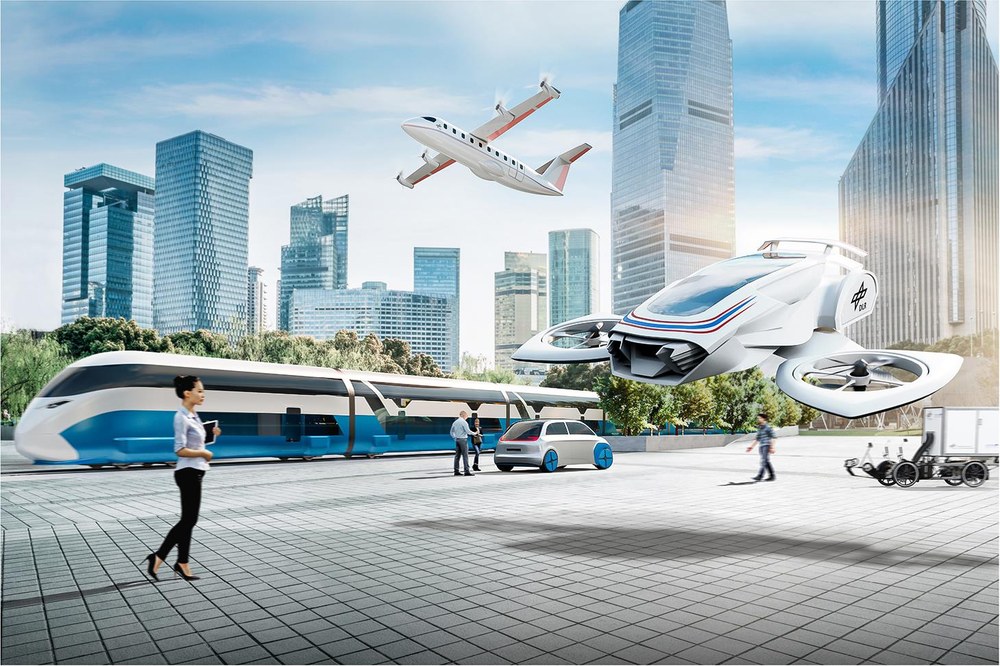Using hydrogen



Green hydrogen is a sustainable alternative to the petrol, diesel, kerosene or fuel oil used today. At the same time, it offers the familiar convenience of long range and fast refuelling. Hydrogen fuel cells are highly efficient and produce no emissions apart from water vapour – in contrast to the direct combustion of hydrogen in engines and turbines. DLR is developing both special fuel cells and new types of hydrogen tanks for mobile use and integrating them into overall systems for cars, buses, lorries, (cargo) bicycles, trains, aircraft and ships. Hydrogen-based propulsion solutions have significant advantages over battery concepts when transporting heavy loads over long distances.
Sustainable hydrogen mobility for road, rail, air and sea
Fuel cell-powered vehicles for private transport are already available and DLR experts are analysing their market potential and applications. Fuel cell powered trains provide an emission-free alternative to diesel on routes without overhead lines. DLR has conducted a study of the market for trains with hybrid-drive concepts and, together with rail vehicle manufacturer Alstom, has developed and tested the world’s first fuel cell-powered multiple unit train. More trains and test regions are set to follow. The first buses with fuel cells are already on the streets as part of pilot projects, while several manufacturers are developing trucks with this type of power train.
Another area of focus is the use of hydrogen for power supply on ships. Possibilities include using hydrogen to provide electricity for both propulsion and cooling the cargo. Research is ongoing into aspects such as service life, practicality for regular daily use and the efficient integration of such systems. DLR also is investigating maritime propulsion systems in cooperation with other research institutions and industry.
In aviation, hydrogen can be used as a fuel in modified gas turbines. This is of particular interest for many classes of aircraft, but it requires the development of aircraft-compatible hydrogen storage systems and new combustion chambers. To date, flying with fuel cells and electric propulsion systems has posed a highly complex technical challenge, but promises to be remarkably quiet, efficient and emission-free. In addition, liquid synthetic fuels based on hydrogen could make flying much more sustainable. In future, such fuels could be used not only in aviation, but anywhere that conventional propulsion cannot easily be replaced with climate-friendly options such as batteries or fuel cells. Power train components and infrastructure need only to be adjusted slightly to exploit alternative fuels. The chemical and physical properties, performance and composition of these climate-neutral fuels are being studied by various institutes, along with cost-effective ways of producing them.
Example projects:
- SLRV – Safe Light Regional Vehicle mit hocheffizientem Wasserstoff-Brennstoffzellen-Antrieb
- Hy4 – Hy4 is the world’s first four-seater passenger aircraft to be powered solely by a hydrogen fuel cell battery system.
- Future Fuels - Future Fuels – DLR's cross-sectoral project is conducting research into synthetic fuels.
Green hydrogen for electricity generation, heating and industry
The energy sector can also benefit from this versatile source of energy. Controllable electricity and heat can be generated using fuel cells and gas turbines. Both are key to satisfying demand peaks in a future energy system supplied by fluctuating renewable sources. Achieving the highest possible efficiency is vital.
Only minor adjustments are required to convert gas power plants that are already working efficiently to hydrogen. DLR is working with turbine and power plant manufacturers to investigate fuel flexibility and the combustion of natural gas and hydrogen mixtures, to make them as burn as stably and cleanly as possible. Scientists are also investigating the industrial viability of hydrogen technologies; in addition to its use in gas turbine power plants, hydrogen produced from renewable sources can be used as a reducing agent in processes such as steel production or ammonia synthesis.
Example projects:
- SUN-to-LIQUID – The process investigated in the SUN-to-LIQUID project uses concentrated solar energy to synthesise hydrocarbon-based liquid fuels from water and carbon dioxide.
- HyBurn – The HyBurn project is developing advanced measurement and simulation techniques needed to better understand combustion dynamics and pollutant formation in gas turbines and support development of combustion chambers suitable for hydrogen-natural gas mixtures.binen hat.
- MENAfuels – The MENAfuels project is analysing the extent to which the MENA region (Middle East and North Africa) can be a strategically important trade partner in supplying Germany and the EU with synthetic fuels or their intermediate products.
- LifetimeINH5000 – Research into solutions to maximise the service life and efficiency of a five-kilowatt PEM fuel cell cogeneration plant.
